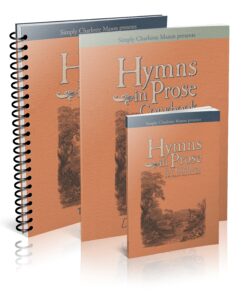60-day returns • free shipping on USA orders $129+


It always intrigues me to find out exact titles that Charlotte Mason recommended in her writings and used in her schools. Recently I came across this recommendation:
Describing the best material to use for reading lessons, Charlotte said,
Short fables, and such graceful, simple prose as we have in Mrs Gatty’s Parables from Nature, and, still better, in Mrs Barbauld’s prose poems, are very suitable. Even for their earliest reading lessons, it is unnecessary to put twaddle into the hands of children (Vol. 1, p. 205).
“Still better.” That phrase made me curious. So I did a little digging and unearthed a brilliant gem that Charlotte had already seen sparkling: Hymns in Prose for Children.
Words fail when I try to describe the brilliance of this book—not just in its breathtaking illustrations but in its equally beautiful text. Yes, it is “graceful, simple prose”; but it also contains some of those interesting words that are appealing to children learning to read, because of their unique look and non-twaddly status. Truly these hymns—in prose, not poetry—well present to the child “the full force of the idea of God” in a beautiful way, “connecting religion with a variety of sensible objects, with all that he sees, all he hears, all that affects his young mind with wonder or delight.”
I was totally drawn in. This book was definitely “still better” than any other reader I had seen.
The only part I personally did not consider “still better” was the fact that the book used Old English terms in the sentences, such as “taketh,” “leadeth,” “guideth,” and “carrieth.” Believe me, I have nothing against that beautiful English, but I thought it might prove to be a hindrance to beginning readers today. It seemed more helpful to have them see today’s most commonly used forms of words in their reading lessons.
Hymns in Prose
And so began a work of love. We located an antique copy, carefully scanned each gorgeous pen-and-ink illustration, cleaned it up, and painstakingly laid the updated text into place. The result is a beautiful reader filled with reverence for God’s handiwork all around—the reader Charlotte Mason recommended, now in modern English but with all the old-fashioned charm: Hymns in Prose for Children.
Then, to help you use the reader with your child, Lanaya Gore wrote more wonderful step-by-step reading lessons in the Charlotte Mason style. Those of you who have used Delightful Reading know how effective that style is and how helpful Lanaya’s lesson plans are for implementing it. And we included a PDF download that contains all the word tiles, letter tiles, and word lists for you to print and use as desired.
But I also wanted a way to reinforce these beautiful hymns. Mrs. Barbauld mentioned the possibility of memorizing and reciting them; and indeed, they would be wonderful used in that way. I found out from personal experience that the more I worked with the inspiring words of the hymns, the more they fed my soul. As Mrs. Barbauld put it, her goal with these hymns was to encourage a child to “see the Creator in the visible appearances of all around him, to feel His continual presence, and lean upon His daily protection.” Then I realized that copywork would prove a valuable tool in helping children slow down enough to weigh each word and meditate on each thought. Thus, Hymns in Prose copybooks were born.
The copybooks come in a variety of styles—both print or cursive, Zaner Bloser or D’Nealian. Each copybook contains selected favorites from the hymns and gently guides the student to make the transition from large-hand writing to regular notebook paper-size writing.
We are thrilled to be able to make these Hymns in Prose resources available to you to use with your advancing reader. Download the free samples and see for yourself why Charlotte deemed Hymns in Prose “still better.”

Sonya, you never cease to amaze me! I always look forward to your emails and eagerly anticipate what treasures they will contain.
Thank you for blessing our family again and again!